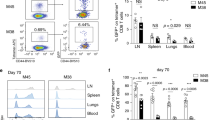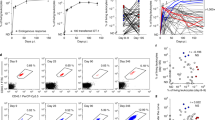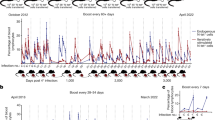Abstract
Memory CD8 T cells, generated by natural pathogen exposure or intentional vaccination, protect the host against specific viral infections1. It has long been proposed that the number of memory CD8 T cells in the host is inflexible, and that individual cells are constantly competing for limited space2,3. Consequently, vaccines that introduce over-abundant quantities of memory CD8 T cells specific for an agent of interest could have catastrophic consequences for the host by displacing memory CD8 T cells specific for all previous infections4,5,6. To test this paradigm, we developed a vaccination regimen in mice that introduced as many new long-lived memory CD8 T cells specific for a single vaccine antigen as there were memory CD8 T cells in the host before vaccination. Here we show that, in contrast to expectations, the size of the memory CD8 T-cell compartment doubled to accommodate these new cells, a change due solely to the addition of effector memory CD8 T cells. This increase did not affect the number of CD4 T cells, B cells or naive CD8 T cells, and pre-existing memory CD8 T cells specific for a previously encountered infection were largely preserved. Thus, the number of effector memory CD8 T cells in the mammalian host adapts according to immunological experience. Developing vaccines that abundantly introduce new memory CD8 T cells should not necessarily ablate pre-existing immunity to other infections.
This is a preview of subscription content, access via your institution
Access options
Subscribe to this journal
Receive 51 print issues and online access
$199.00 per year
only $3.90 per issue
Buy this article
- Purchase on Springer Link
- Instant access to full article PDF
Prices may be subject to local taxes which are calculated during checkout




Similar content being viewed by others
References
Christensen, J. P., Doherty, P. C., Branum, K. C. & Riberdy, J. M. Profound protection against respiratory challenge with a lethal H7N7 influenza A virus by increasing the magnitude of CD8+ T-cell memory. J. Virol. 74, 11690–11696 (2000)
Freitas, A. A. & Rocha, B. Population biology of lymphocytes: the flight for survival. Annu. Rev. Immunol. 18, 83–111 (2000)
Goldrath, A. W. Maintaining the status quo: T-cell homeostasis. Microbes Infect. 4, 539–545 (2002)
Welsh, R. M., Selin, L. K. & Szomolanyi-Tsuda, E. Immunological memory to viral infections. Annu. Rev. Immunol. 22, 711–743 (2004)
Surh, C. D., Boyman, O., Purton, J. F. & Sprent, J. Homeostasis of memory T cells. Immunol. Rev. 211, 154–163 (2006)
Sad, S. & Krishnan, L. Maintenance and attrition of T-cell memory. Crit. Rev. Immunol. 23, 129–147 (2003)
Masopust, D., Ha, S. J., Vezys, V. & Ahmed, R. Stimulation history dictates memory CD8 T cell phenotype: implications for prime–boost vaccination. J. Immunol. 177, 831–839 (2006)
Woodland, D. L. Jump-starting the immune system: prime–boosting comes of age. Trends Immunol. 25, 98–104 (2004)
Wherry, E. J. et al. Lineage relationship and protective immunity of memory CD8 T cell subsets. Nature Immunol. 4, 225–234 (2003)
Selin, L. K., Vergilis, K., Welsh, R. M. & Nahill, S. R. Reduction of otherwise remarkably stable virus-specific cytotoxic T lymphocyte memory by heterologous viral infections. J. Exp. Med. 183, 2489–2499 (1996)
Selin, L. K. et al. Attrition of T cell memory: selective loss of LCMV epitope-specific memory CD8 T cells following infections with heterologous viruses. Immunity 11, 733–742 (1999)
Schluns, K. S. & Lefrancois, L. Cytokine control of memory T-cell development and survival. Nature Rev. Immunol. 3, 269–279 (2003)
Masopust, D., Vezys, V., Wherry, E. J., Barber, D. L. & Ahmed, R. Cutting edge: gut microenvironment promotes differentiation of a unique memory CD8 T cell population. J. Immunol. 176, 2079–2083 (2006)
Jabbari, A. & Harty, J. T. Secondary memory CD8+ T cells are more protective but slower to acquire a central-memory phenotype. J. Exp. Med. 203, 919–932 (2006)
Antia, R., Ganusov, V. V. & Ahmed, R. The role of models in understanding CD8+ T-cell memory. Nature Rev. Immunol. 5, 101–111 (2005)
Jackola, D. R. & Hallgren, H. M. Dynamic phenotypic restructuring of the CD4 and CD8 T-cell subsets with age in healthy humans: a compartmental model analysis. Mech. Ageing Dev. 105, 241–264 (1998)
Czesnikiewicz-Guzik, M. et al. T cell subset-specific susceptibility to aging. Clin. Immunol. 127, 107–118 (2008)
Hammarlund, E. et al. Duration of antiviral immunity after smallpox vaccination. Nature Med. 9, 1131–1137 (2003)
Pantaleo, G. & Koup, R. A. Correlates of immune protection in HIV-1 infection: what we know, what we don’t know, what we should know. Nature Med. 10, 806–810 (2004)
Sekaly, R. P. The failed HIV Merck vaccine study: a step back or a launching point for future vaccine development? J. Exp. Med. 205, 7–12 (2008)
Kaiser, J. AIDS research. Review of vaccine failure prompts a return to basics. Science 320, 30–31 (2008)
Shiver, J. W. & Emini, E. A. Recent advances in the development of HIV-1 vaccines using replication-incompetent adenovirus vectors. Annu. Rev. Med. 55, 355–372 (2004)
Lefrancois, L., Olson, S. & Masopust, D. A critical role for CD40–CD40 ligand interactions in amplification of the mucosal CD8 T cell response. J. Exp. Med. 190, 1275–1284 (1999)
Murali-Krishna, K. et al. Counting antigen-specific CD8 T cells: a reevaluation of bystander activation during viral infection. Immunity 8, 177–187 (1998)
Hunter, R. L., Kidd, M. R., Olsen, M. R., Patterson, P. S. & Lal, A. A. Induction of long-lasting immunity to Plasmodium yoelii malaria with whole blood-stage antigens and copolymer adjuvants. J. Immunol. 154, 1762–1769 (1995)
Slifka, M. K., Matloubian, M. & Ahmed, R. Bone marrow is a major site of long-term antibody production after acute viral infection. J. Virol. 69, 1895–1902 (1995)
Acknowledgements
We thank S. Jameson, E. J. Wherry and A. Haase for critical discussions and reading of the manuscript, and J. W. Yewdell for recombinant vaccinia virus. This research was supported by start-up funds from the University of Minnesota Medical School (V.V. and D.M.) and NIH grant AI30048 (R. Ahmed).
Author information
Authors and Affiliations
Corresponding author
Supplementary information
Supplementary Information
This file contains Supplementary Figures S1-S5 with Legends (PDF 875 kb)
Rights and permissions
About this article
Cite this article
Vezys, V., Yates, A., Casey, K. et al. Memory CD8 T-cell compartment grows in size with immunological experience. Nature 457, 196–199 (2009). https://doi.org/10.1038/nature07486
Received:
Accepted:
Published:
Issue Date:
DOI: https://doi.org/10.1038/nature07486
This article is cited by
-
Regulation of tissue-resident memory T cells by the Microbiota
Mucosal Immunology (2022)
-
Expansible residence decentralizes immune homeostasis
Nature (2021)
-
Tissue-resident memory CD8+ T cells shape local and systemic secondary T cell responses
Nature Immunology (2020)
-
Developmental plasticity allows outside-in immune responses by resident memory T cells
Nature Immunology (2020)
-
Demarcated thresholds of tumor-specific CD8 T cells elicited by MCMV-based vaccine vectors provide robust correlates of protection
Journal for ImmunoTherapy of Cancer (2019)
Comments
By submitting a comment you agree to abide by our Terms and Community Guidelines. If you find something abusive or that does not comply with our terms or guidelines please flag it as inappropriate.



